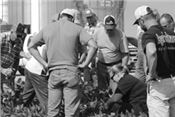MU Extension Plant Pathologist: Don't Treat All Soybean Diseases With Fungicides

University of Missouri Extension plant pathologist Kaitlyn Bissonnette shows soybean farmers how to scout for disease during a recent scouting school.
Photo credit: Photo by Linda Geist
HAWK POINT, MO.
Not all soybean diseases require a fungicide application, says University of Missouri Extension plant pathologist Kaitlyn Bissonnette.
Knowing if and when to spray fungicides saves money and reduces concerns about fungicide resistance, Bissonnette says.
She shares information about soybean diseases in a series of sessions on disease scouting throughout the state. Missouri Soybean Merchandising Council and MU Extension sponsor the sessions.
Timing, method and rate of application determine fungicide efficacy, says Bissonnette. Many common diseases don't affect yield and don't warrant treatment.
Always follow label instructions for best results. Fungicides applied too early often lack efficacy, Bissonnette says. Little fungicide may remain on leaves by the time disease shows. Most disease does not require a fungicide application before early pod development (R3 growth stage).
Bissonnette says farmers should check weather patterns and the disease-resistance level of their varieties when making fungicide application decisions. Regular scouting of the field, starting at the edges and walking to the interior areas, provides early detection of pests. Know your diseases. Some are easily identified while others are harder to distinguish from other types of crop damage, she says. An integrated pest management system that includes crop rotation and the use of resistant varieties is always the best approach.
Bissonnette gives a brief overview of diseases that seldom require foliar fungicide treatment:
• Septoria brown spot shows as brown spots in the lower canopy of soybean. It often appears early in the season. The disease causes leaves to yellow and drop prematurely but does not generally affect yield. It thrives during warm, wet weather and in continuous soybean fields. Rotate fields to avoid.
• Bacterial leaf spot appears in the upper canopy as small brown or light green spots surrounded by yellow halos. Both it and septoria brown spot appear around the same time and can be confused. It also does not affect yield and requires no treatment.
• Downy mildew first appears as pale green or light yellow blotches on the upper surface of young leaves. On the underside of the leaf, a gray, fuzzy growth appears after heavy dews. Fungicides are not recommended to control downy mildew. Crop rotation and clean seed are the best management options. ∆
Note: Part 2 of this 2 part series will be in next week’s publication.